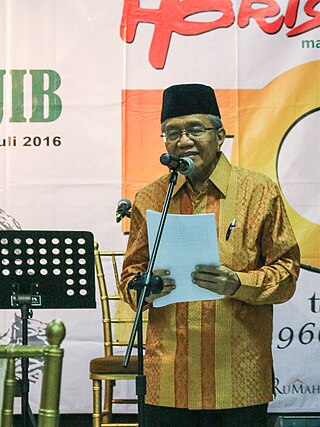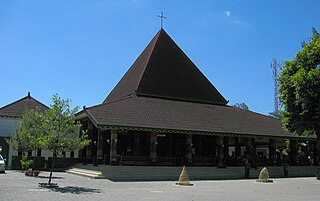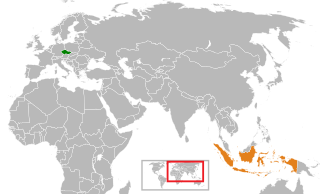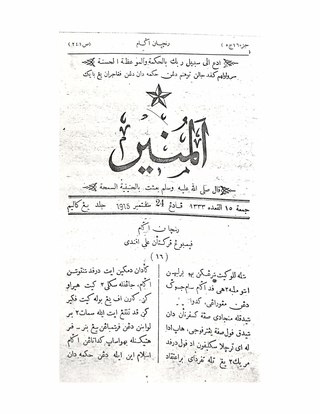Inscription text
This page is a candidate for copying over to Wikisource. |
The text of Lobu Tua Inscription is as follows: [8]
| 1-4. Now, in 1010 Saka, the month of Masi |
Lobu Tua Inscription, also called Barus Inscription, is an inscription written in Tamil language which was discovered in 1873 in the village of Lobu Tua, Andam Dewi district of Central Tapanuli Regency, in North Sumatra Province, Indonesia. [1] This inscription is dated 1010 Saka, or 1088 AD. [1] This inscription was reported in the Madras Epigraphy Report of 1891-1892 by E. Hultzsch, an English epigraphist in India. [1]
The inscription mentions the existence of a Tamil trade union in the Barus region. [2] The trade union was named "The Five Hundreds of a Thousand Directions" (Disai-Ayirattu-Ainnurruvar). [2] [3] According to Prof. Y. Subbarayalu from Tamil University, Thanjavur, this trade union's other name was Ayyavole , which also left a Tamil-language inscription in Aceh. [4] In Barus, they bought various commodities from the local population, and the members were collected excise in the form of gold, which was based on the price of the kasturi. The objects of the excise were the ship, the captain, and kevi. [2]
According to reports, in the 1900s a Buddha statue in the form of a torso made of red granite was also found in the site, which is now gone. [2] The existence of the statue in Barus raises the suspicion that the Tamil community there was permanent or semi-permanent, therefore it has its own place of worship. [2]
Currently 7/8 parts of the inscription are stored in the National Museum of Indonesia and another one eight part is still in Lobu Tua. [5] Beside inscriptions, in Lobu Tua some dry old cylindrical wells were found as well. [6] [7]
This page is a candidate for copying over to Wikisource. |
The text of Lobu Tua Inscription is as follows: [8]
| 1-4. Now, in 1010 Saka, the month of Masi |

George Cœdès was a French scholar of southeast Asian archaeology and history.

Pagaruyung, also known as Pagarruyung, Pagar Ruyung and, Malayapura or Malayupura, was a kingdom that once stood in the island of Sumatra and the seat of the Minangkabau kings of Western Sumatra. Modern Pagaruyung is a village in Tanjung Emas subdistrict, Tanah Datar regency, located near the town of Batusangkar, Indonesia.
A number of medieval inscriptions written in Tamil language and script that have been found in Southeast Asia and China, mainly in Sumatra and peninsular Thailand. These texts arose directly from trade links between south India and certain parts of Southeast Asia and China, which involved the residence in those regions of Tamil-speaking Indians. Several of these overseas Tamil inscriptions mention well-known medieval Indian merchant associations.

Taufiq Ismail is an Indonesian poet, activist and the editor of the monthly literary magazine Horison. Ismail figured prominently in Indonesian literature of the post-Sukarno period and is considered one of the pioneers of the "Generation of '66". He completed his education at the University of Indonesia. Before becoming active as a writer, he taught at the Institut Pertanian Bogor. In 1963, he signed the "Cultural Manifesto" as a document that opposed linking art to politics. This cost him his teaching position at the Institut.

The Jakarta History Museum, also known as Fatahillah Museum or Batavia Museum, is located in the Old Town of Jakarta, Indonesia. The building was built in 1710 as the Stadhuis of Batavia. Jakarta History Museum opened in 1974 and displays objects from the prehistory period of the city region, the founding of Jayakarta in 1527, and the Dutch colonization period from the 16th century until Indonesia's Independence in 1945.

Kanjeng Raden Mas Tumenggung Wongsonegoro, more commonly known simply as Wongsonegoro, was an Indonesian politician, who served as the Deputy Prime Minister of Indonesia, alongside Zainul Arifin under Prime Minister Ali Sastroamidjojo, and the Governor of Central Java during the Indonesian National Revolution. He also served as minister in the Indonesian government a number of times, including Minister of Home Affairs, Minister of Justice, and Minister of Education.
Denys Lombard was a leading Asian expert with contributions to Southeast Asian studies, Sinology, and the history of maritime Asia. He was famous for efforts to compare insular Southeast Asia and the Asian Seas to the Mediterranean area.

Tamil Indonesians are persons from Indian Tamil ancestry living in Indonesia. Majority of them live in Medan in North Sumatra while there are small community in other parts of the country such as Jakarta, Aceh, Riau and Riau Islands. It is estimated that there are around 25,000 PIOs/NRIs living in Indonesia of which the Indian expatriate community registered with the Embassy and Consulate in Medan numbers around 30,000.

The Church of the Sacred Heart of Jesus, also known as the Ganjuran Church, is a Roman Catholic church located in Ganjuran, Bantul, Special Region of Yogyakarta, Indonesia. It is the oldest church in its administrative regency.

Pareh, released internationally as Pareh, Song of the Rice, is a 1936 film from the Dutch East Indies. Directed by the Dutchmen Albert Balink and Mannus Franken, it featured an amateur native cast and starred Raden Mochtar and Soekarsih. The story follows the forbidden love between a fisherman and a farmer's daughter.
Putu Oka Sukanta is a versatile Indonesian author of fiction and poetry. He wrote poetry, short stories and novels while still in Bali and after he moved to Yogyakarta and Jakarta. From 1966, during the New Order, he was imprisoned without trial as an alleged member of LEKRA. After his release in 1976, he has come to be known as a writer, journalist and an expert in the field of traditional medicine.

Dapunta Hyang Sri Jayanasa was the first Maharaja of Srivijaya and thought to be the dynastic founder of Kadatuan Srivijaya. His name was mentioned in the series of Srivijayan inscriptions dated from late 7th century CE dubbed as the "Siddhayatra inscriptions", describing his sacred journey to acquire blessings and also to conquer neighboring areas. He reigned around the turn of late 7th century to early 8th century, more precisely in the period between 671 and 702 CE.

I Gusti Ketut Pudja was an Indonesian politician and national hero, who served as the first governor of Lesser Sunda from 1945 until 1946. He was a member of the Investigating Agency for Preparatory Work for Indonesian Independence (BPUPK). He was also present at Admiral Tadashi Maeda's house, during the preparation for the Proclamation of Indonesian Independence on 17 August 1945. Making him the only Balinese to be present during the proclamation.

Barus is a town and kecamatan (district) in Central Tapanuli Regency, North Sumatra Province, Sumatra, Indonesia. Historically, Barus was well known as a port town or kingdom on the western coast of Sumatra where it was a regional trade center from around the 7th or earlier until the 17th century. It was also known by other names, namely Fansur and possibly Barusai. The name Fansur or Pansur means "spring of water" or "a place where water flows" in the local Malay language/Batak language. Barus was well known for its produce camphor. In the 16th century, Barus came under attack from the rising power of Aceh, and became absorbed into the Aceh Sultanate. The earliest known Malay poet Hamzah Fansuri may be from Barus as indicated by his name.

The Czech Republic and the Republic of Indonesia established diplomatic relations in 1950. Both nations have agreed to forge ties to deepen relations, especially in the business and trade sector. Indonesia has an embassy in Prague, while the Czech Republic has an embassy in Jakarta that is also accredited to Brunei, Timor Leste, Singapore and ASEAN, and honorary consulates in Bali, Makassar and Surabaya.
Samaskuta was an ancient kingdom in Sumatra's interior, at the location of present-day Lake Singkarak. Little is known about its founding, but the kingdom is known to have existed before the eruption of Krakatoa in the 5th century. It is believed that the Kingdom sank into Lake Singkarak after the volcanic explosion. In the book Pararaton, Prabhava Sangkala is mentioned as the king of Samaskuta in AD 416.

Said Rasjad served as acting mayor of Padang, bupati of Agam, and regent of Padang Pariaman.

Purwokerto Station (PWT) is a large type A railway station located in West Purwokerto, Banyumas Regency, Central Java, Indonesia. The station is located at an altitude of 75 m. It is the largest station under the management of PT Kereta Api Indonesia (Persero) Operation Area V Purwokerto. As a large station, all trains that pass through the Prupuk–Kroya railway line must stop at this station.

Al-Munir was an Islamic magazine, written in Arabic-Malay, published in Padang from 1911 until 1915. Inaugurated by the initiative of Abdullah Ahmad in early April 1911, Al-Munir was listed as the first Islamic mass media in Indonesia. The magazine was often associated with Al-Imam magazine published under the direction of Sheikh Tahir Jalaluddin in Singapore during 1906-1909. In addition to Abdullah Ahmad, several religious figures such as Abdul Karim Amrullah, Muhammad Thaib Umar and Sutan Muhammad Salim were recorded in the ranks of the editorial board.

Kebonkopi II inscription or Pasir Muara inscription or Rakryan Juru Pangambat inscription is the oldest inscription that mentioned the toponymy Sunda dated from 854 Saka, discovered in Kebon Kopi village, Bogor, near Kebon Kopi I inscription, and named as such to differ it from this older inscription dated from Tarumanagara era.